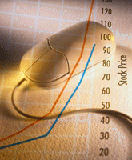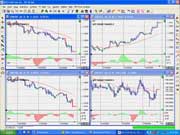Do Your Forex Analysis Via Forex Charting Techniques
Forex trading is done in the Forex market, also known as the foreign exchange market. With the foreign exchange market, you don't trade in stocks or bonds; instead, you trade in what are called currency pairs. That means that you pick one currency from one particular country and determine whether or not it's going to do better or worse against another country's currency.
There are several things you study to determine whether a particular currency is going to do well or not. Chief among these is how well a country is doing, socially, politically and economically. For that, you use something called fundamental analysis.
With technical analysis, though, you read Forex charting that tells you how a particular currency is trending. Is it going up, going down, or staying the same against the other currency in your pair? Has it been doing so for a while, or has it been volatile?
Once you've been trading in Forex enough so that you know the ropes, you can make predictions based upon what your Forex charting tells you. If a currency has been doing well for a while, it's likely that it's going to continue to do well for at least the time being. If it's going down, then it may be time to get out of that particular trade.
When you begin to "trade" in Forex, you should do so at first by establishing something called a "demo" or practice account with the Forex trader you pick. With demo trading, you can do everything the average Forex trader does, only you don't have to use real money. This lets you practice without risking any money until you fully know your way around the Forex market and feel comfortable risking your own money in trades.
That leads us to an important point. With Forex trading, you are absolutely taking a risk when you do trades. It is indeed a very lucrative market for those who know what they're doing, but you still are not guaranteed that you'll make money. For this reason, demo trading also lets you do something very important. It lets you psychologically get used to losing money.
That's an important point as well, because even the most successful Forex traders do lose money sometimes. Absolutely no one wins on every single trade. Because Forex trading does require a cool head, you're going to have to learn to leave your emotions out of the equation. That means if you're winning on the trade, you need to read and analyze charts carefully to determine whether or not you should get out even if the trade is still doing well. By the same token, you should know when to get out of a trade that's losing instead of staying in, in hopes that she'll make the money that you've lost back.
A lot of practice and the proper Forex charting techniques can make you a successful trader, too, as long as you know what you're doing and can handle yourself. Many people have made a successful sideline or even livelihood out of Forex trading, and you may be one of them.


